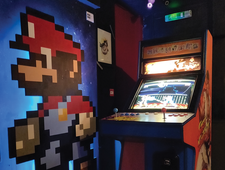Setting up a dgamelaunch game server
A Blast from the Past

© Photo by Kevin Borrill on Unsplash
If you are into retrogaming, dgamelaunch lets you set up a server to play Roguelike games and compete with friends, all while preserving a piece of gaming history.
In the early '80s, Rogue, a game that would overhaul the gaming world, was released. According to Roguelike Gallery, Rogue first ran on a PDP-11 machine running Unix v6 [1]. Primitive by today's standards, Rogue popularized the Roguelike genre despite not being the first game of its kind. Rogue's influence can be seen in modern commercial titles. Rogue's source code is still available, as are many games that pre-date Linux.
In this article, I show how to set up a server to host antique terminal games. Why would you want to do this? Besides preserving a piece of history, playing these games is fun despite their age. In addition, running games on a specific server allows you to keep scoreboards, letting you compete against friends on a shared server. Last, but not least, setting up a game server is an instructive exercise.
Service Architecture
This article assumes you are using Debian, which unlike early 16-bit Operating Systems, is capable of using modern connectivity protocols.
[...]
Buy this article as PDF
(incl. VAT)
Buy Linux Magazine
Subscribe to our Linux Newsletters
Find Linux and Open Source Jobs
Subscribe to our ADMIN Newsletters
Support Our Work
Linux Magazine content is made possible with support from readers like you. Please consider contributing when you’ve found an article to be beneficial.

News
-
Two New Distros Adopt Enlightenment
MX Moksha and AV Linux 25 join ranks with Bodhi Linux and embrace the Enlightenment desktop.
-
Solus Linux 4.8 Features Removes Python 2
Solus Linux 4.8 has been released with the latest Linux kernel, updated desktops, and a key removal.
-
Zorin OS 18 Hits over a Million Downloads
If you doubt Linux isn't gaining popularity, you only have to look at Zorin OS's download numbers.
-
TUXEDO Computers Scraps Snapdragon X1E-Based Laptop
Due to issues with a Snapdragon CPU, TUXEDO Computers has cancelled its plans to release a laptop based on this elite hardware.
-
Debian Unleashes Debian Libre Live
Debian Libre Live keeps your machine free of proprietary software.
-
Valve Announces Pending Release of Steam Machine
Shout it to the heavens: Steam Machine, powered by Linux, is set to arrive in 2026.
-
Happy Birthday, ADMIN Magazine!
ADMIN is celebrating its 15th anniversary with issue #90.
-
Another Linux Malware Discovered
Russian hackers use Hyper-V to hide malware within Linux virtual machines.
-
TUXEDO Computers Announces a New InfinityBook
TUXEDO Computers is at it again with a new InfinityBook that will meet your professional and gaming needs.
-
SUSE Dives into the Agentic AI Pool
SUSE becomes the first open source company to adopt agentic AI with SUSE Enterprise Linux 16.

